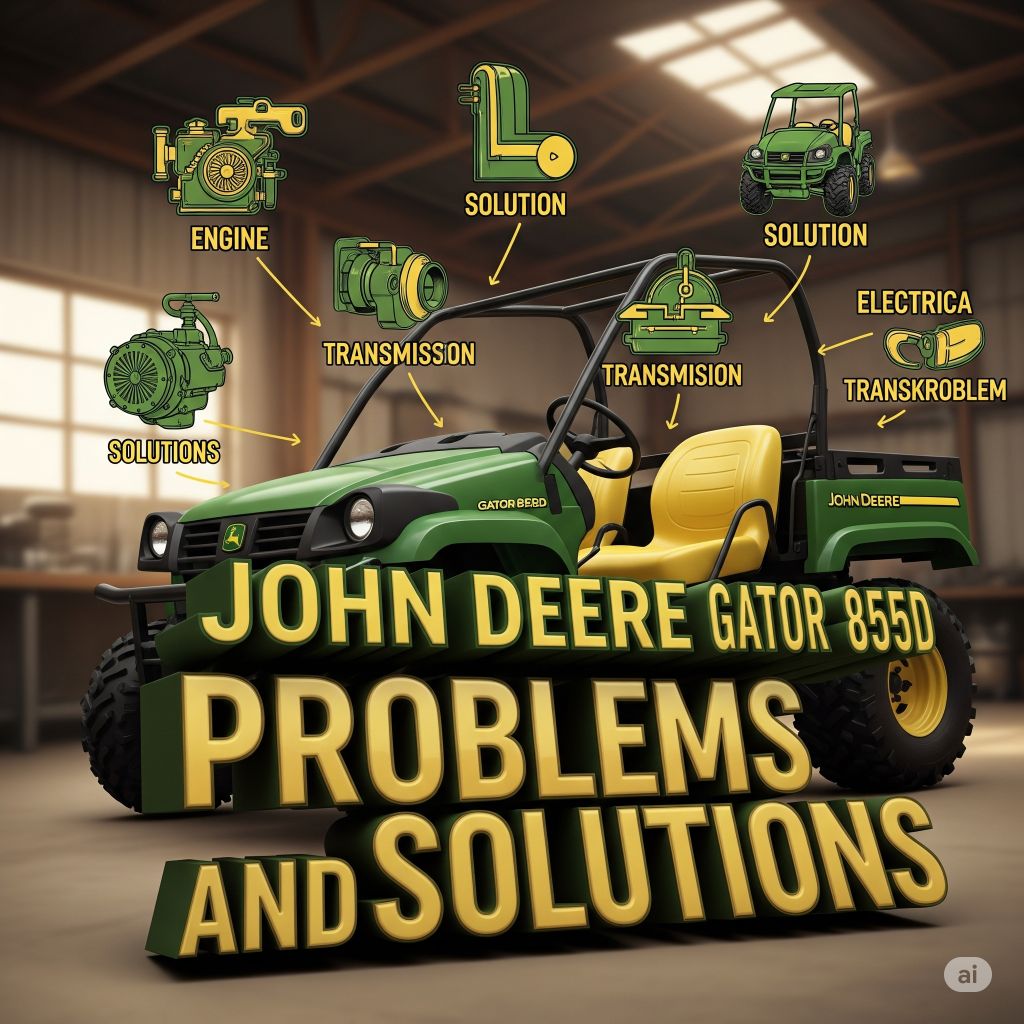
Here’s in-depth guide on the John Deere Gator 855/855D—covering specs, frequent issues, solutions, real-world user stories, and what to watch out for.
🚧 John Deere Gator 855 / 855D Overview (Specs & Design Highlights)
- Engine: Yanmar 3-cylinder diesel (approx. 25–35 HP, model dependent)
- Transmission: Electric-over-hydraulic CVT (belt-driven clutch, no manual clutch)
- Drive Options: 2WD or selectable 4WD
- Brake: Mechanical parking brake, disc brakes (on 4WD); hydrostatic brake engagement
- Payload: ~1,000 lb cargo bed, limited towing (1,500 lb)
- Speed: Factory-limited to ~25 mph
- User Base: Common among small farms, sport fields, estates, and light-duty contractors
🔍 Common Problem Areas & Fixes
1. Hard or No-Start Situations
- Symptoms: No crank, slow crank, or inconsistent ignition
- Root Causes: Weak battery, corroded terminals/grounds, faulty starter or solenoid, blown fuse, or interior relay failure
- Solutions: Perform load-testing on battery, clean and tighten grounds and connectors, check starter/solenoid health, replace errant fuses — see real case here where cold solder joints in an intake heater relay prevented start-up.
2. Belt-Related Slip, Lurch or Jerky Engagement
- Symptoms: Lurch forward at low RPM, hesitation when engaging drive, belt drag
- Cause: Primary clutch may stick closed; belts may bleed oil or accumulate debris
- Fixes: Clean clutch assemblies with compressed air, ensure proper tension, replace belt if worn or contaminated.
3. Difficult Shifting & CVT Behavior
- Symptoms: Hard shifting into gear, jerky takeoff especially from standstill
- Causes: CVT belt binding, wrong belt tension, delayed clutch engagement
- Fixes: Warm up the engine before shifting; regularly inspect shift cable and belt tension; service CVT per schedule . Many owners report smoother movement above ~5 km/h; at very low speeds it’s common to stall or feel drag .
4. Electrical & Ignition Troubles
- Symptoms: Dashboard displays go dark, ignition fails, fuse blows when using accessories
- Causes: Loose or corroded terminals, fly-by-wire connectors, failing fuse panel
- Fixes: Inspect fuse layout under dash, clean wires, and ground cables. In one case, no-start plus dead lights traced to a blown fuel solenoid fuse triggered by a short to ground
5. Fuel & Engine Performance Issues
- Symptoms: Rough idle, incomplete combustion, surging, poor acceleration
- Cause: Fuel pump failure, clogged injector or fuel filter, bad spark or glow wires
- Fixes: Test fuel pump voltage and wiring, replace harness connectors if corroded; maintain filters; inspect spark plug wiring for damage
6. Overheating Under Load
- Symptoms: Rapid high temperature, engine derate after extended runs
- Causes: Clogged radiator or cooling passages, fan engagement delay, low coolant
- Fixes: Clean cooling fins, check fan temp switch, inspect thermostat, ensure coolant topped off. Avoid long high-RPM runs without airflow (Mr. Motor Problems).
7. Steering & Brake Issues
- Symptoms: Stiff steering, whining power steering pump, poor braking downhill with load
- Causes: Low power steering fluid, aged pumps, worn tie rods, brake fade under cargo
- Fixes: Top up or change power steering fluid, lubricate steering linkage, upgrade brake pads if carrying load regularly (Offroad Official).
📦 Real Owner Experiences (from forums & Reddit)
“The rear linkage fittings were rusty—needed coating and lube… steering felt plasticky and cheap…” (Reddit).
“At 495 hrs it still needed tires—dealer miles are real…”
“CVT jerkiness at crawl speed is normal—but once moving above 5 km/h, smooth”
🧰 Key Maintenance and Reliability Tips
- Battery Health: Replace every 2–3 years; store indoors in cold climates.
- CVT Belt Servicing: Clean clutch packs every 200 hrs; adjust shift cable; warm engine before shifting.
- Fuel & Electrical: Inspect connectors under dash; replace corroded plugs; blow out clutch clean.
- Cooling Checks: Pre-season flush, pressure check fan switch, clean radiator fins.
- Steering & Brakes: Grease tie rods, bleed power steering system, inspect brake engagement under cargo weight.
✅ Pros & ⚠️ Cons Summary
| Feature | Pros | Cons / Concerns |
|---|---|---|
| Engine / Power | Robust diesel, efficient for light-duty use | Overheating if airflow obstructed or under load |
| Transmission | Smooth CVT for highway/high-speed use | Jerky low-speed behavior, belt drag issues |
| Construction | Durable chassis, strong load capacity | Plastic panels, rust-prone linkages |
| DIY-Friendly | Electric components are modular and replaceable | Proprietary electronics can block third-party repair |
| Dealer Support | John Deere parts network access | Engine rebuilds costly; limited independent access |
❌ Watch for These Situations: When to Walk Away
Avoid Gator 855/855D units if:
- They have frequent starting/intermittency issues, especially tied to poor wiring or relays.
- CVT belt has never been serviced and dragging persists at low RPM.
- Cooling has no maintenance records and exhibits visible denting, blockage, or overheating signs.
- Leaking or soft steering, or inconsistent brakes under cargo—especially after low-speed maneuvering.
- Gator has been road-driven regularly at top speed—Gators aren’t designed for constant 45 mph travel and it’s rough on belts/transmission
🔧 Sample Fix Case: Intake Relay Surprise
As one user shared: a John Deere 855 with bent valve and burned piston turned out to have a faulty intake heater relay—cold-soldered and intermittent—once fixed, the tractor started and ran fine. The original owner never identified the root cause until a detailed teardown. Moral: minor connectors can cause major failures.
🧭 Final Verdict
The John Deere Gator 855 remains a dependable utility vehicle for homeowners, contractors, and turf operations—if well maintained and responsibly operated. Most issues stem from wear items, electrical connectors, CVT belt drag, or cooling neglect—not catastrophic design flaws.
✅ Recommended if: You can inspect cable and clutch states, your dealer is within reach, and the unit has solid maintenance history.
⚠️ Skip or negotiate hard if: CVT shifting is rough at low RPM, PTO switch or relay problems persist, signs of overheating are frequent, steering stays stiff, or tires need replacement already.
Would you like a printable upkeep checklist, wiring nut list, or a side‑by‑side comparison of Gator vs other UTVs like Kubota RTV or Polaris Ranger?

I’m David man behind Lawn Mowerly; I’ve been dealing with lawnmowers and Tractors with my father since I was a kid. I know every make and model and what each one is capable of and love helping people find the perfect equipment for their needs.
